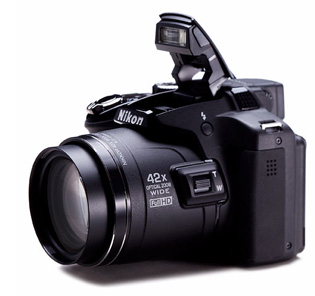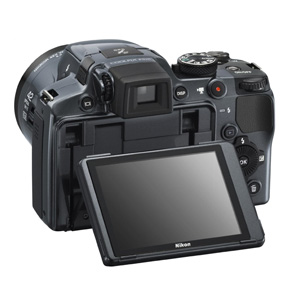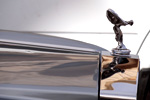Best Superzoom Cameras under $500
ALSO RAN:
Nikon Coolpix P510
Nikon Coolpix P510
The Nikon Coolpix P510 which replaced the P500 this spring has a whopping 41.7x zoom range, the longest zoom on the market at the moment in the superzoom bridge camera category, a 24-1000mm equivalent. The next closest model in maximum zoom range is the Canon SX40 with its 35x range and max 840mm.
New features on the P510 that did not exist on the P500 include not only the longer zoom range, but onboard HDR, 3D photos, GPS, a slightly wider aperture (f/3.0 vs f/3.5), a boost from 12 MP to 16 MP resolution, and optical image stabilization instead of sensor shift.
The P500 did not do so well in our initial superzoom bridge shootout, coming in a distant fourth place. The more robust and feature laden P510 shows an improvement in value, making it more competitive with the Sony HX100V, but it retains some of the shortcomings and flaws of the P500, so the improvements are not major enough to justify a change in the rankings.
 |
What's HOT about the Nikon P510:
1. It's 41.7x zoom will attract buyers who want the longest possible zoom range.
2. Widest of the wide angles-24mm matches the Canon SX40 and is slightly wider than the Panasonic FZ150 at 25mm.
3. Relatively bright viewfinder, much better than the SX40
4. 3" diagonal, whopping 920,000 dot high res LCD screen--best in the group.
5. Panorama mode--people like it, and the Canon SX40 doesn't have it.
6. Zoom control has hard stop at optical to digital transition--Excellent! Why can't they all do this?
7. 3D photos
8. Onboard GPS
9. HD movies at 1080p/30, 720p, and high speed low res movies at 240 fps (all about average for the group)
10. Easy to use menu layout.
 |
What's NOT so hot about the Nikon P510:
1. Picture quality falls short of the Panasonic FZ150, sharp at wide angle but soft at max telephoto
2. No eye proximity sensor--must manually switch between viewfinder and screen
3. Slow focus, and sometimes unreliable
4. Focus problems in video mode, re-seeks focus with each shift of the zoom, and has a hard time focusing at max zoom.
5. LCD screen gets smudged if you use the viewfinder
6. Reds tend to bias toward orangish-red.
7. Loses color saturation at higher ISOs, more so than the Canon SX40 or Pan FZ150.
8. No RAW mode--only the Panasonic FZ150 and the Fuji HS30 have in this group
9. No hot shoe--if you need external flash power, forget about it
A Look at the Nikon Coolpix P510
The Nikon P510 is a good step forward beyond the P500. It is compact and light compared to the Fuji HS30, and only slightly larger than the Panasonic FZ150. It can take great pictures in the wide and mid-range of the zoom lens. Unfortunately photos tend to soften toward the telephoto end. But with the 1000mm maximum zoom compared to the Canon SX40's 840mm or the Panasonic FZ150's 600mm, the P510 gets you closer to your subject than the competition can manage. And if you are not blowing image files up to large scale for printing, the softness in the telephoto end of the lens is something you may never notice.
The big trade-off with the P510 against the the current "Best Superzoom Camera," the Panasonic FZ150, is the same as the trade-off between the Canon SX40 and the FZ150--sharpness vs closeness. In each case the FZ150 renders a sharper image, but can't get quite as close due to the limit of its maximum 600mm lens.
To illustrate, the following photos were taken with the Nikon P510 and the Panasonic FZ150, both at maximum zoom, hand held. The subject is a second floor balcony about 75 yards away. Here's what these two cameras gave us:

Nikon P510, hand-held, max zoom, cropped detail 100% pixel view

Panasonic DMC-FZ150, hand-held, max zoom, cropped detail 100% pixel view
Though the FZ150 renders a sharper image, it does not have the reach. So the question is, what do you want? A closer view or a sharper image? The answer to that depends entirely on how big you plan to display your photos. IF you are keeping them to Facebook size, the extra zoom reach of the P510 will be of greater value to you because you won't notice the softness at that size. Or to put it in reverse, the extra sharpness of the Panasonic FZ150 won't be of any benefit since all photos from both camera will look sharp enough.
For example, here is the cinderblock wall comparison, with both cameras at maximum zoom from a distance of 42 feet from the wall. These full frame photos have been compressed to just under 300 pixels wide. As you can see, the P510 has a significant advantage in magnification AND it actually looks sharper:


Panasonic FZ150 Nikon P510
(from a distance of 42 feet)
The bottom line is that it is vitally important to know what you intend to do with your photos. IF you are sharing photos on Facebook, the differences in sharpness we just saw above while pixel peeping at 100% are entirely irrelevant. But the zoom range could be everything. If this is you, then the Nikon P510 might be your best choice in the entire group.
Focus in video mode. In video mode, the Canon SX40 and Panasonic FZ150 both do a better job of maintaining continuous focus than the P510. Every move of the zoom control on the P510 causes the camera to go through a refocusing cycle during which the image is blurry for a second or two, so it is not really possible to create videos that maintain a sharp image. When video goes in and out of focus as you are watching it, it drives you buggy. It is this factor more than any other that keeps the P510 in fourth place behind the Sony HX100V. Like the Fujifilm HS30, the P510 is not a camera you'd want to choose if you intend to do a lot of video.
Color saturation. In moderate light, the P510 shows low color saturation. If you look at this Photoscope comparison between the P510 and the Panasonic FZ150, you will see a deeper blue on the sea salt label, and a much deeper red on the Colman's label and on the red/white checkered fabric. As you move the lens around the scene, virtually every color is muted on the P510, and it only gets worse as you move the ISO selection tool to higher ISOs.
No proximity sensor. Another chronic nuisance is that the P510, like the P500 before it, has no proximity sensor. The Sony HX100V has a great one--when you put your eye up to the viewfinder, the camera automatically activates the viewfinder and turns off the LCD screen. When you take the camera away from your face, the viewfinder shuts off and the LCD screen comes on. This is a beautiful thing for ease of use, but for some reason Nikon has not seen fit to include it on their superzoom cameras. If you take a picture using the P500 or P510's viewfinder, and you want to see the pic you just took on the LCD screen, you need to manually switch from the viewfinder to the screen by pressing a somewhat inconvenient button on the upper left side of the camera. This gets old in a hurry.
The Verdict
The Nikon P510 is a new and improved P500, but the P500 was not a stellar camera to begin with. Though the zoom is lengthened from 36x to 42x, making it unrivaled in the zoom range department, the focus issues we found troubling on the P500 have not been fully resolved. The softness in the long end of the lens, the inability to maintain clean focus in video mode and the lack of a proximity sensor, all detract from what could be a terrific camera.










